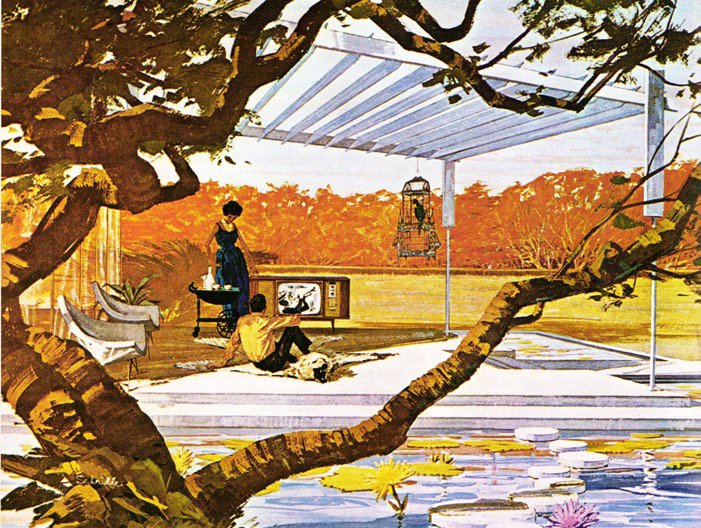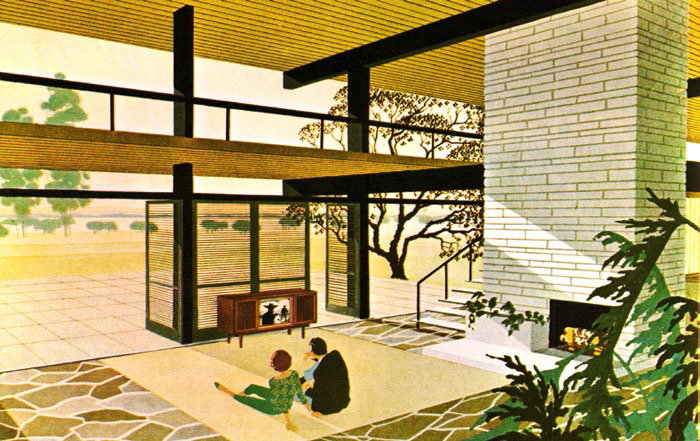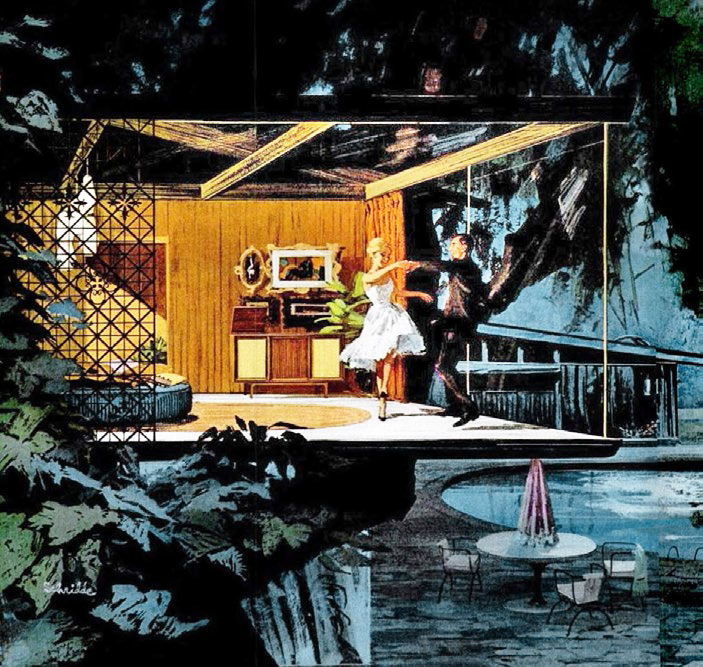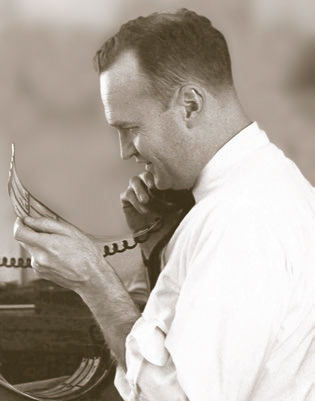
Dreamlike Homes Anchored Ad Campaign
 |
|
|
Is it surprising that the most beautiful of all mid-century modern homes are those that have never existed? Back in the 1960s, when artist Charles Schridde and colleagues were drawing these ‘Dreamscapes of Elegance,’ which we visit in the new winter ’19 issue of CA-Modern magazine, the images of elegant people in beyond-elegant modern homes were set in some imagined 'future.'
Today we admire them with nostalgia for their almost unimaginable optimistic outlook.
Schridde, who was based in Detroit at the time, created images of homes that floated above rivers, that almost hovered in space, that served as party houses for sophisticated dancing, or as relaxation zones for watching the tube.
And it was the tube that these images were all about. They were part of what historian Sue Topp today calls “futuristic print advertising” for Motorola televisions, hi-fi equipment, and other such goods.
 |
|
|
“I surveyed the Motorola, Inc. Legacy Archives Collection and found that we have print proofs or digital copies for 22 ads in what I have dubbed the ‘Motorola futuristic lifestyle’ consumer products ad series produced for Motorola by Leo Burnett Company from around 1961 to 1963,” Topp wrote.
“In addition to Charles Schridde, artist names on the ads include Eyvind Earle and Leon Deller. We can't assume the series is all by Charles Schridde.”
Topp, manager of heritage communications and archives at Motorola Solutions, Inc., the successor firm to Motorola Consumer Products Inc., delved into this popular (both then and now) series of amazing advertisements, which ran in the early 1960s in Life magazine and Saturday Evening Post, and perhaps other magazines too.
Topp has pointed out how the imagery of these modern homes should be seen as integrated with the advertising copy that ran alongside. Ads brag that “Motorola’s Dynamic Sound Focus brings a realism and ‘presence’ to stereo sound that should delight the ear of any audiophile.” Motorola was selling what it called integrated hi-fis with 'Vibraphonic sound.'
 |
|
|
Clearly, Motorola wanted readers to associate its equipment with a vibrant, even miraculous future. (Yet, ironically perhaps, the styling of most of the TV and stereo equipment shown is traditional. The TVs and stereos are always the most un-futuristic thing in the illustrations.
Charles Schridde (1926-2011, pronounced Shrid-ee) seems to have been the lead designer for this campaign. The fantastical homes that he created for the ads are “dreamscapes,” in the words of Santa Monica graphic designer Steve Kosareff.
“They were unique,” says Kosareff, author of the book ‘Window to the Future: The Golden Age of Television Marketing and Advertising.’ “I don’t remember anything like them.”
“They have a very landscape, wide-screen format so your vision is surrounded in it when you’re looking at in a magazine.”
Although most of the illustrations for that series were by Schridde, at least two other illustrators produced images. And one architect either created illustrations, or contributed to them by supplying architectural designs.
 |
|
|
The best known of these artists, both today and at the time, was Eyvind Earle (1916-2000), a prolific watercolor artist and designer who did well in the 1940s with a line of Christmas cards, and won fame in the 1950s and ‘60s designing for Walt Disney. Earle was responsible for the backgrounds and general look for such Disney films as ‘Peter Pan’ and ‘Sleeping Beauty.’
George Bertels, who also drew fantastical home settings for Motorola, was another commercial artist working in Detroit. For a time in the 1960s he drew illustrations for Corvette News magazine. Some of the Motorola ads were also designed by an architect named Leon Deller.
Surprisingly, according to his daughter, Melanie Schridde, Charles Schridde never expressed interest in modern architecture – though it must be said she was born in 1968, years after his Motorola venture.
There is no record of Schridde ever drawing anything as wildly modern as his Motorola campaign again, though he drew mid-century modern homes in at least a few other works. Schridde did much of his commercial work for Detroit automakers.
Melanie has said her father got the Motorola assignment by answering the challenge to show “a neat place to watch TV.”
“I don’t know how he came up with those ideas,” she says. “He used photos for his paintings and would have models pose. He would combine a photo of a sailboat and a person and a dog, and people dancing.”
“For one Motorola ad, there’s an image of a woman peering through these bushes. That was a photo of my mom peering through bushes,” she says.
For more on Charles Schridde and the Motorola dreamscapes, read ‘Dreamscapes of Elegance,’ a sneak preview of the new winter ’19 issue of CA-Modern magazine.
 |
|
|
- ‹ previous
- 155 of 677
- next ›



